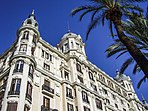Alicante in Alicante

|
Alicante (or Alacant as it is called in Valencian) is the smallest and most southern of Valencia’s three provinces. It borders the provinces of Murcia, Albacete and Valencia and, to the east, the Mediterranean Sea. The province of Alicante covers an area of 5,816km2 and has a population of 1,836,000 (2016). Its capital city – Alicante – is officially at only 0 m above sea level. This is the height of the location of the Town Hall, which is the measure all Spanish towns and cities’ height is based upon. However, there are neighbourhoods at up to 80 m above sea level, and the Mount Benacantil, where the emblematic Castillo de Santa Barbara is situated, is 169 m high. The population of the city is 330,525 (2016) inhabitants which makes it the 11th most populated city in Spain.
Alicante is an attractive city with the Castillo de Santa Barbara dominating the skyline, its wide, white beach, the large marina with its luxury yachts and leisure crafts and the busy trading port. The city centre is a bustling mixture of large avenues and small pedestrian streets with café tables under sun umbrellas. The triangle made up of Rambla de Méndez Núñez, Avenida de Alfonso X El Sabio and Avenida de Maisonnave is great for shopping, and there are both small, traditional shops and large chain stores and national and international franchises, something for everybody. We all seem to think of the airport when we hear the name Alicante, but there’s much more to it than that, go see for yourself! HistoryThe Iberians were the oldest documented people living in what today is the Alicante province. Belonging to these there are several archaeological sites from which is specially known the one in La Serreta (near Alcoy) because the longest inscriptions remaining in the undeciphered Iberian language were found there. The Alicante area was first populated about 7,000 years ago, when Central European hunters and gatherers settled on the slopes of Mount Benacantil. At about 1000 BC all along the coast and contemporarily to the Iberians, the seafaring Phoenicians (in Guardamar) and Greeks (along the coastal section to the north of the Alicante city) settled stable trading colonies and interacted with the former (see Lady of Elche for the most renowned archeological piece of this period). Greek and Phoenician traders started visiting the eastern coast of the peninsula and founded the first trading ports. Alicante was founded by the Greeks in 324 BC and was conquered by the Romans in 201 BC. Romanization in this part of Iberia was intense, the Via Augusta communicated this part of the Empire to the metropoli and so several cities thrived, from which the one known as Ilici Augusta (now Elche) even reached the status of colonia. The Romans named it Leucanto, and there are still archeological remains to be found at the original site, some three kilometers north of the present city centre. Leucanto fell into Moorish hands in 718 AD and remained part of the Al Ándalus realm under the name Al-Laquant until it was finally conquered by the Christians in 1248. From the 13th century, kings like Ferdinand III of Castile, James I of Aragon, Alfonso X of Castile, James II of Aragon reconquered the cities that Moors occupied. Since then it has belonged to various Spanish kingdoms through the centuries, and it was granted city status by Fernando el Católico in 1490. Alicante suffered badly during the Spanish civil war as it remained staunchly republican/socialist throughout. It was bombed repeatedly by the Phalangists, but in spite of this, it was one of the last Republican strongholds to surrender to General Franco’s forces. What today is the Alicante province was initially split between the Crown of Castile and the Crown of Aragon by means of the Treaty of Almizra, however later on the whole territory became under the control of the Kingdom of Valencia, which was a component Kingdom of the Crown of Aragon.
|
|
||||||||||||||||||||||||||||||||||||||||||||||||||||||||||||||||||||||||||

 Not least thanks to its extensive port facilities, commerce thrives in Alicante and it is the 5th largest trade centre of Spain. Tourism, which dates back to the 19th century and really took off in the mid 1950s, is also a major player in the Alicante economy, partly due to the benign weather and its beautiful beaches, but also thanks to the wide range of leisure activities on offer with a range of theme parks, tourist attractions and fantastic shopping. Also the estate agency business thrives in Alicante, to a great extent buoyed up by the vast amount of tourists that visit the area, fall for it and decide to realize their dream of Life in the Sun. Industry, on the other hand, is of less importance to the Alicante economy and employs only 5.7% of the active population.
Not least thanks to its extensive port facilities, commerce thrives in Alicante and it is the 5th largest trade centre of Spain. Tourism, which dates back to the 19th century and really took off in the mid 1950s, is also a major player in the Alicante economy, partly due to the benign weather and its beautiful beaches, but also thanks to the wide range of leisure activities on offer with a range of theme parks, tourist attractions and fantastic shopping. Also the estate agency business thrives in Alicante, to a great extent buoyed up by the vast amount of tourists that visit the area, fall for it and decide to realize their dream of Life in the Sun. Industry, on the other hand, is of less importance to the Alicante economy and employs only 5.7% of the active population.









